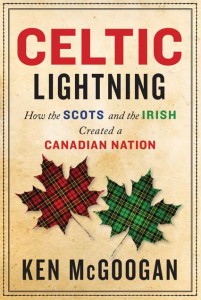Celtic lightning: how the Scots and the Irish created a Canadian nation
Published in Book Reviews, Issue 2 (March/April 2016), Reviews, Volume 24KEN McGOOGAN
HarperCollins
$29.99
ISBN 9781443425506
Reviewed by Dean Jobb

Celtic lightning ends with a beginning. Author Ken McGoogan describes how, in 1863, two political opponents joined forces with a common goal—to unite four of Britain’s North American colonies and form a new country, Canada. John A. Macdonald was a Glasgow-born political dynamo, a master of building alliances and wielding power. Thomas D’Arcy McGee, a former Irish rebel turned Canadian nationalist, had the eloquence and charm needed to win over opponents and sceptics. Together, the Scottish pragmatist and the Irish visionary oversaw the negotiations that led to Canada’s establishment as a self-governing dominion in 1867. ‘Their alliance,’ McGoogan argues, ‘marks a reunification of a Celtic people divided for centuries’, and offers proof that Celtic values have been imprinted in Canada’s cultural DNA.
McGoogan, one of Canada’s leading writers of popular history, explores how Irish and Scottish immigrants—together, their descendants account for about a quarter of Canada’s population of 35 million—shaped their new country. Celtic lightning focuses on five key ‘cultural, social and political values’ they brought with them: democracy, pluralism, independence, perseverance and audacity. ‘I sought the attitudes and principles,’ the author explains, ‘that underlie Canada at its best.’
Unlike McGoogan’s previous books on the great Arctic explorers of the nineteenth century, this is not a narrative history. Memoir and character studies drive the book forward, and McGoogan draws on his extensive tours of Ireland and Scotland and visits to historic sites to bring Celtic history to life. He makes time-travelling leaps through a thousand years of Irish and Scottish history to introduce an array of characters who exemplify the five ‘bedrock’ values that crossed the Atlantic to Canada. Pirate queen Grace O’Malley, Catholic emancipator Daniel O’Connell, independence leaders Charles Stewart Parnell and Michael Collins and other figures he profiles will be well known to Irish readers, but their impact on the history and development of the Canadian nation may come as a surprise. O’Malley is audacity personified, and McGoogan sees her as a role model for any number of pioneering, successful Canadian women of today, from Nobel prize-winning author Alice Munro to activists, judges and even a former Canadian governor-general. In Parnell’s parliamentary struggle for Home Rule the author sees a reflection of the Canadian tradition ‘of effecting political change not through violent revolution, but by political means’.
Authors Oscar Wilde and James Joyce seem odder choices as sources of Irish influence on Canada. Wilde lectured on art in more than a dozen Canadian cities during an 1882 speaking tour of North America, but McGoogan finds a deeper connection—as inspiration for the acceptance of diversity that made Canada one of the first countries to legalise same-sex marriage. Joyce’s stream-of-consciousness writings, meanwhile, influenced Canadian communications guru Marshall McLuhan, remembered for his 1960s maxim, ‘The medium is the message’.
The cultural exchange works both ways. The Anglo-Irish Treaty that Michael Collins negotiated in 1921 fell short of winning outright independence, but it was a compromise that granted Ireland the same status as Britain’s other self-governing dominions. In fact, Canada was cited as the model in the treaty’s text; Ireland would have ‘the same constitutional status in the community of nations known as the British Empire as the Dominion of Canada’. McGoogan sees Collins—who was among the victims of the civil war that followed the treaty’s ratification—as a leader who fought for change ‘along Canadian lines … through evolution rather than revolution’.
Despite the title, Celtic lightning is focused more on Irish and Scottish history than on Canada. Some of his Irish exemplars of Celtic values visited Canada (including Parnell and Dublin-born John Palliser, who surveyed western Canada’s prairies and mountain ranges in the 1850s) but many had no direct connection to the country.
McGoogan is a third of the way through the book before he profiles his only Irish-Canadian subject, journalist-turned-politician Thomas D’Arcy McGee. Born in Carlingford, he fled to the United States as a young man after supporting the failed uprising of 1848, and moved on to Montreal in 1857. McGee was an author, journalist and skilled orator who gravitated to politics and became a passionate advocate for Britain’s remaining North American colonies to form a new country within the Empire. His pro-British stance put him at odds with the extremist Fenian Brother-hood, however, and made him a marked man; he was gunned down on an Ottawa street in 1868. ‘One of the great tragedies of Canadian history,’ McGoogan writes, ‘is that a Fenian assassin removed the Irish statesman before he had finished his work.’
McGoogan’s goal is to help Canadians better understand their cultural heritage, and in this he succeeds in convincing fashion. His profiles and insights leave no doubt that Canadians owe much to the courage and foresight of their Celtic ancestors. Irish readers who know the historical back story, though, may long for a deeper understanding of Canada’s history and development and how these transplanted Celtic values played out in their new surroundings. Canadians, McGoogan writes, ‘thought, wrongly, that our history stopped at the Atlantic Ocean’. Celtic lightning leaves little doubt that oceans and time are no barriers to the exchange of cultural values and ideas.
D.R. O’Connor Lysaght is the editor of One hundred years of Liberty Hall (ILHS, 2014). His From the GPO to the Winter Palace will be published shortly.
















